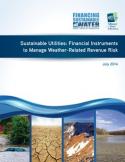Sustainable Utilities: Financial Instruments to Manage Weather-Related Risk

A white paper examining market-based strategies, such as derivatives and insurance, which are available to water managers and can be applied to help them mitigate the revenue risks associated with unpredictable weather.
Water providers are facing rapidly evolving and increasingly volatile weather patterns that affect customer use and water supplies. Extremely wet or extremely dry seasons can have a significant impact on a utility’s sales, net revenue and debt service coverage ratios. Furthermore, multiple years of undesirable weather and resulting revenue shortfalls could force a lower bond rating, which will then lead to increased interest expense for a sustained period of time.
Weather-related financial instruments have long been utilized successfully in industries such as energy and agriculture, and have also been previously used by municipalities to hedge against other weather risks such as snow removal). Encouraged by an idea raised at the 2012 Summit on declining water sales, AWE sought to understand whether these tools could be viable additions to the utility manager’s toolbox of strategies for increasing fiscal sustainability and support more traditional strategies such as cost-based rate setting and financial policies.
“We hope that this white paper will spark discussion and further investigation into how market-based solutions can be applied to help utilities better secure their long-term financial health,” said Mary Ann Dickinson, President and CEO of the Alliance for Water Efficiency. “Utilities need to examine innovative solutions to today’s evolving landscape of declining water use, erratic weather patterns, and growing strains on supplies.”
This paper examines the types of instruments available to municipalities, the components of a pricing structure, and how similar products have been used by municipalities in the past. It also constructs several sample contracts and pricing for diverse risks utilities may face, and demonstrates how they decrease weather-related risks related to revenues and costs.





